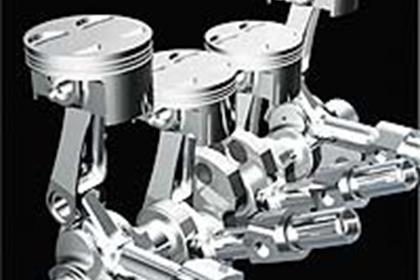More bhp at a stroke
IMAGINE riding a 600cc sports bike that turns into a 750 at the twist of the throttle. No nitrous, no big-bore kit, just ready power.
It sounds like fantasy, but this is the reality of a radical new engine that could be in production in just three years.
A surge of power linked to a rise in capacity and a change in the compression ratio is the tantalising prospect in the world’s first ” intelligent ” engine.
It will burn cleanly, and at a stroke will make power-sapping catalytic converters redundant, while giving more mpg while you are cruising.
The inventor of this wonder engine is bike engineering legend Dr Joe Ehrlich, 87, who promises his ” e3 ” design will make traditional four-stroke theory redundant.
Ehrlich is one of the world’s great engine designers. He built a supercharged two-stroke back in 1948 that was so powerful it was banned from competition. He built many race-winning engines, powering the likes of Mike Hailwood. His EMCs also took four Isle of Man TT victories in the 1980s.
So when Ehrlich says it’s a breakthrough in design, we should believe him. To prove it works, he has a single-cylinder engine on a test bed, capable of changing from 270cc to 300cc and altering the compression ratio from a soft 9:1 to a peppy 14:1.
” It has done hundreds of hours with no problems, ” said Ehrlich. ” It runs quietly and so smoothly you can balance a coin on its edge at the top of the engine while it’s running. ”
After a century of four-stroke design following a similar arrangement of crankshaft, connecting rod and piston, the intelligent engine makes big changes.
Instead of the conrod’s big end being attached directly to the crank, it joins a lever. At the other end of the lever is a sliding pivot point.
As the pivot is moved up and down, and towards and away from the crank, the lever alters the position of the big end. This brings two key benefits which mean more power and efficiency.
First, there’s an angle between the conrod and the crank at top dead centre. On a conventional engine, the crankshaft, big end and small end line up at this point, when combustion pressure is at its highest.
This means the pressure can’t immediately start turning the engine. Only after the crank has moved can the pressure start producing power.
The Ehrlich engine changes this, putting the peak pressure to work.
Secondly, instead of the big end following a circular path, it has an elliptical motion.
This means the piston moves relatively slowly after the spark of ignition, allowing more of the fuel to burn, which in turn makes the engine more efficient and more powerful.
Also, power continues to be fed to the crankshaft for an extra 10° of crank movement, again extracting extra power from the fuel. And, on the intake stroke, there’s more time for fuel to be drawn in, to give the power stroke more energy.
Ehrlich says you can tell that more power has been extracted from the fuel because the exhaust gas is a lot cooler than that from a conventional engine.
A small amount of the extra power produced has to be absorbed by the extra moving parts and the hydraulics that move the pivot point.
The designer claims the losses are tiny, and the extra space taken up by the levers may make only 20mm difference to the size of a crankcase, although this will depend on the capacity increase required.
” The engine changes its capacity and compression automatically, ” explained Ehrlich. ” It uses the kind of sensors that are standard in modern engines.
” You can be cruising along on your 600 at 60mph when the compression will be at 14:1 for best efficiency, and as you accelerate you’ll have 680cc or more in one quick step. It sounds complicated, but it’s a lot less complex than some modern engines.
” Another advantage is that the variable compression makes it ideal for supercharging. My engine is in a new world of technology, making a lot of established ideas redundant and opening up many new possibilities. ”
Ehrlich has developed the e3 engine with the giant Mayflower group, which makes commercial vehicles and car bodies for major manufacturers.
Its intention is to see companies like Honda take out licenses to produce versions of the intelligent engine. Introducing the design doesn’t demand big changes to existing engines, so the e3 could be put on a fast track to production.


